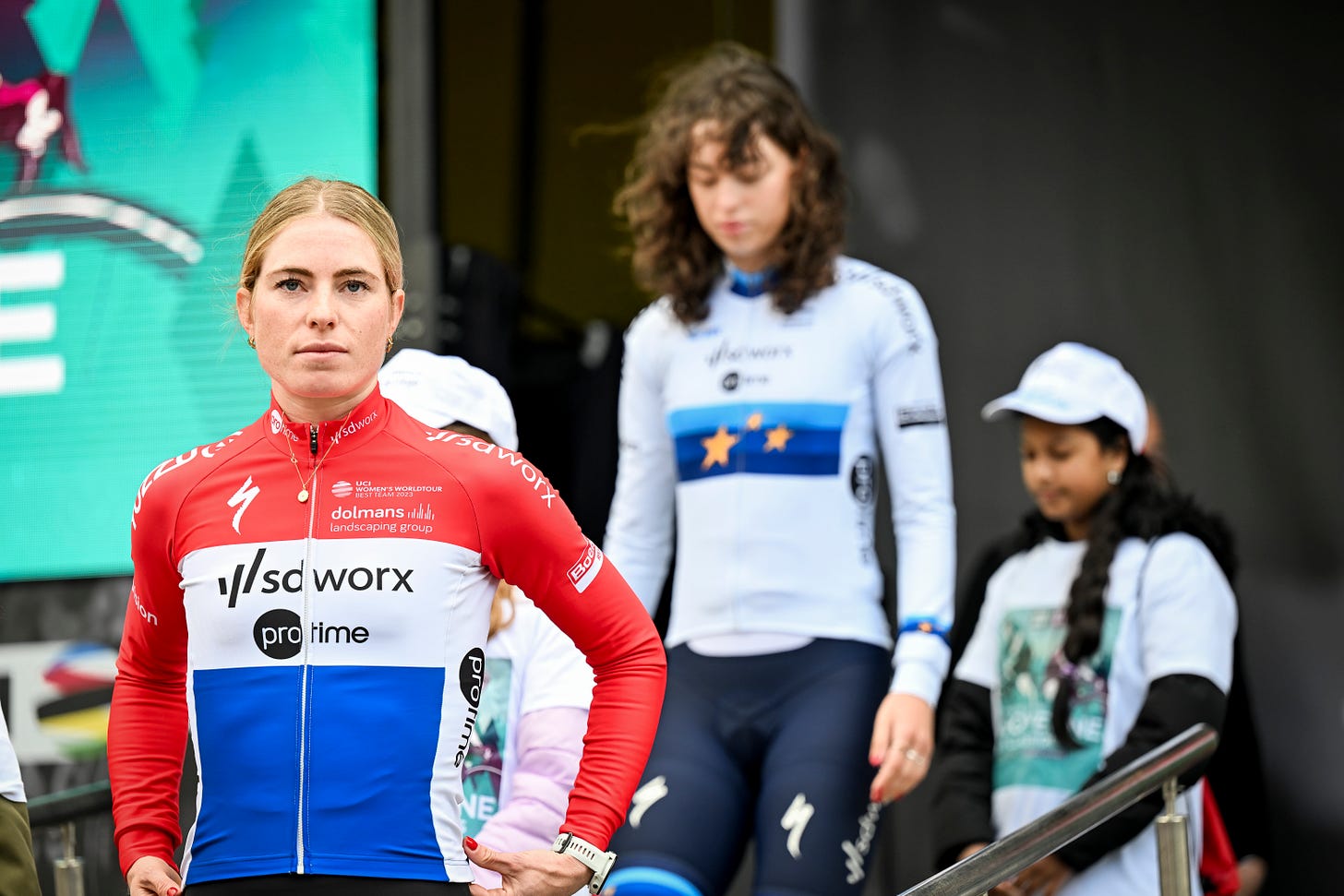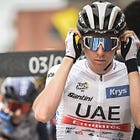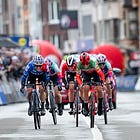Between the World and Demi
Vollering and Pogačar seek a career-validating stint in the rainbow jersey
The thing about the maillot jaune of the Tour de France is that you don’t get to wear it forever. Once it’s won, it goes in a frame in your trophy room. Apart from a couple exhibition criterium races1 put on by ASO in the offseason, you never wear it again. You don’t get special armbands for the rest of your career. It’s a memory
The rainbow jersey of the world champion is different. It’s one of few trophies that you wear to work every day, and considering that former world champions are entitled to put rainbow bands on their sleeves, you can wear if for the rest of your career.
A time trial world championship is cool, but that discipline is contested so rarely it barely gets shown off. After Remco Evenepoel won his first world time trial championship in 2022, he trotted out the rainbow jersey on just three racedays in the ensuing season. Hilariously, his three biggest time trial victories—Stage 7 of the Tour de France, the Olympics, and the 2024 World Championships—came with Remco wearing other kits. I don’t know why he even bothered.
But the road race champion’s bands get shown off every day. Winning this race can be career-defining, as it was for Peter Sagan and Julian Alaphalippe. Or career-validating, as it was for Alejandro Valverde. Or career-making, as it was for Mads Pedersen.
Those who show up to race this weekend will know the value of what they’re racing for.
We see big upsets in one-day races, even one-day races of this stature, pretty frequently. I don’t think this parcours lends itself to a surprise result.
The biggest reason: It’s so fucking hilly. There is basically nowhere on this course for the peloton to come together and work to chase down breakaway groups, and there’s nowhere for weaker (or just heavier) riders to take a breather between climbs. This parcours is mostly composed of a circuit around southeastern Zurich. The women do it four times and the men do it, like six and three quarters times.2 The featured climb of the day is the Witikon, which is less than two kilometers in length but tops out at close to a 10 percent gradient. And it keeps going up—there are further bumps in the road before the descent.
Going over this punchy hill again and again and again isn’t going to be good for a big breakaway, especially given that world championships—in contrast to the Olympics—allows teams big enough to carry dedicated domestiques. Instead, I expect something similar to what happened in the women’s Olympic road race (a small group gets away and fights it out near the end) or men’s Liège-Bastogne-Liège and Strade Bianche (one rider makes a long break and nobody else can get organized enough to chase him or her down).
Either way, I expect someone who has the juice—and I’m trying to to say literally Tadej Pogačar, but it’ll probably be Pogačar—to attack on one of the earlier laps, and whoever is able to follow that early move to stick to their wheel. Behind, the cohesion of the chase group is going to collapse. If only one rider makes it off the front, they’ll solo to victory. If it’s more than one, maybe we’ll see something unexpected. This parcours is just too tough for the underdogs.
The men’s race features pretty impressive depth. Team USA is bringing Matteo Jorgenson, Brandon McNulty, and Neilson Powless, and while I don’t know exactly how this race will play out, those three riders have pretty much any eventuality covered. Plus Magnus Sheffield to pull in what little flat ground there is, and Sean Quinn to run down attacks.
Ireland is bringing Ben Healy, who would be among the favorites in this race if GC guys weren’t allowed. Ditto Switzerland and Marc Hirschi, and Canada with Mike Woods and Derek Gee. France has a deep squad led by Julian Alaphilippe, who might be cooked, and Romain Bardet, who might not be cooked, even if he’s retiring at the end of the year. Bardet came closer than anyone else to following Pogačar’s attack at Liège-Bastogne-Liège and ended up finishing second.
I have no idea how this race could end up in a reduced bunch sprint, but if it does, we’ve got Pedersen, Biniam Girmay and Michael Matthews. Team Great Britain doesn’t have a rider who’s perfect for this parcours, but it does have—in Stephen Williams, Tom Pidcock, and the Yates twins—a bunch of riders who are decent for this parcours and could make noise in rolling attacks.
Mathieu van der Poel headlines the Dutch team, and while this course is probably too climb-y for him, he did manage to finish on the podium at Liège-Bastogne-Liège.
But there are two riders in top form and built perfectly for this course. The first is Pogačar, who’s had this circled on his calendar all year.
The Triple Crown of Cycling—the Tour GC, the Giro GC, and the world road race championship in the same season—has been completed twice, in 1974 by Eddy Merckx and in 1987 by Stephen Roche. Which basically makes it like hitting 60 home runs a season: The first two guys to do it were the mythical allfather of the sport and a dude who put so much into the effort it basically ruined his career. Then there were a bunch of guys who did steroids, and now we’ve got a physical mutant the likes of which we never thought we’d see.
Against all odds, Pogačar has completed the first two legs with ease. He is Aaron Judge in this metaphor. And after skipping the Olympics and the Vuelta, he returned to action two weeks ago to race the Laurentian Classics, where he won the GP de Montreal over a field that included Bardet, Woods, Gee, Alaphilippe, Jorgenson, Healy and Simon Yates.
Here’s what usually happens in a big one-day race with a hilly parcours and a loaded startlist. Pogačar3 launches from like 60 kilometers out. Nobody puts in the effort to chase him down, because nobody wants to burn a match putting down the effort to catch him, only to get dropped later by Pogačar and whatever chasers they’ve brought along. Pogačar, by this point alone and like a minute up the road, toodles away to victory while everyone else bickers over who wants to be the sacrificial lamb to chase him down. This squabbling continues as Pogačar extends his lead to 90 seconds, then two minutes, at which point Wout van Aert says, “Fine, I’ll fuckin do it!” and takes up the chase.
Van Aert makes some headway, then gets frustrated as nobody else does any work, and sits up. Maybe later on, there’s a solo attack that nobody seriously thinks is capable of catching Pogačar, and it doesn’t, but it’s good enough to take second. And van Aert smokes everyone in the reduced bunch sprint for third.
Only van Aert isn’t coming to Zurich.
The only way I don’t see this happening is if Remco Evenepoel can follow Pogačar’s initial attack—maybe he doesn’t stick to his wheel, but he can at least keep it close. Pogačar might be the best in the world going uphill, but Remco is one of very few riders who can match him for consistent long-range power over varied terrain. If Remco can make it a two-man break, that’d definitely take the sting out of any other counterattack. In that case, any team that pulls to chase down the two favorites would not only be dragging back a deep Belgian squad, but Primož Roglič as well. This kind of gets lost, but Roglič is the last rider other than Remco or Pogačar to win Liège-Bastogne-Liège.
If Pogačar goes alone, he’s imperturbable. But put him in a sprint of three or four riders and things can get dicey. Pogačar has seven World Tour-level classic or monument wins since the start of 2023; six of them have come by a margin of 15 seconds or more. The only exception, 2023 Flèche Wallonne, was in a race that’s only ever decided on one climb. Pogačar ordinarily doesn’t like to leave it that late, which is why he keeps coming up short at Milan-San Remo. If Remco can stay with Pogačar, he can win.
But that’s a big if. Especially considering the magnitude of the achievement facing Pogačar right now. As much as winning an Olympic and a World Championship double in the same year—neither of which had ever been done by a man before—would be a special achievement for Remco, it’s a trivia answer compared to the Triple Crown.
So give me Pogačar for the win, followed by Remco in second, and let’s give Healy the Romain Bardet Memorial Doomed Attack for the Podium, and the bronze medal.
The favorite in the women’s race, like Pogačar, has also (somewhat inexplicably) never won the world championship before. Demi Vollering is the heir to the throne of Marianne Vos, Annemiek van Vleuten and Anna van der Breggen as the dominant Dutch rider of her time, but she’s yet to put on the rainbow jersey.
But this is a puncheur’s course, and she’s the best puncheur out there. Moreover, she’s got a deeper team than her biggest rival, defending champ Lotte Kopecky. I’ve seen a shot-in-the-dark prediction that someone like Puck Pieterse might be used as bait for Kopecky and end up in a position to solo to victory. I’m skeptical. I think Vollering can basically just ride everyone else off her wheel on a course with this much climbing.
Can Kopecky keep up? It’s possible, but like van der Poel, I think she’s just slightly too big for this course. I also wonder if Kristen Faulkner can deal with this much climbing; as powerful as she is, and with the flawless tactical instincts she’s shown, she ought to be a threat. But Faulkner is absolutely positively not a climber.
The one thing that’s keeping me from writing her off completely is Strade Bianche in 2023. Faulkner was then a relative unknown riding for Jayco-Alula when she went to the last climb with Vollering and Kopecky, only to DSQ’d later. Faulkner is better now than she was 18 months ago, and that course featured 1,942 vertical meters of climbing over 136 kilometers. This course is 154 kilometers in length with roughly 2,200 meters’ worth of climbing. That’s more, but not by orders of magnitude. And if Faulkner has leadership of Team USA, she’ll have great time trialists like Chloe Dygert and Amber Neben pulling for her. It’d be a bigger upset than her win in the Olympics, but it’s not impossible.
If I had to look for a threat to Vollering, beyond Kopecky and maybe Kasia Niewiadoma, I’d look to Australia. It’s not that the Aussies have one particularly scary rider, but they have strength in depth.
That said, Grace Brown did beat a decent-size group of favorites—including Vollering, Niewiadoma and Elisa Longo Borghini—in a sprint to win Liège-Bastogne-Liège. If that’s actually a comparable course, Brown winning the most recent edition should hold some weight. And Brown can team up with Sarah Gigante and 22-year-old climber Neve Bradbury, who’s quietly had a great season, finishing on the podium at the UAE Tour, the Tour de Suisse and the Giro. (Bradbury was 11th at Liège-Bastogne-Liège.)
But just as with Pogačar, I feel like I’m grasping at straws, trying to invent a scenario in which Vollering could lose. I don’t think the margin is quite as big on the women’s side, but anything other than the two favorites winning these races would come as a surprise. Give me a podium of Vollering, Kopecky and Brown.
I should say, “races,” since these are glorified gran fondos that pay big money for stars to show up and wave to fans
The world championship parcours actually looks exactly like the default course for the U.S. national road race championships in PCM 2021
Or sometimes van der Poel








It turned out that Vollering's team was too deep.